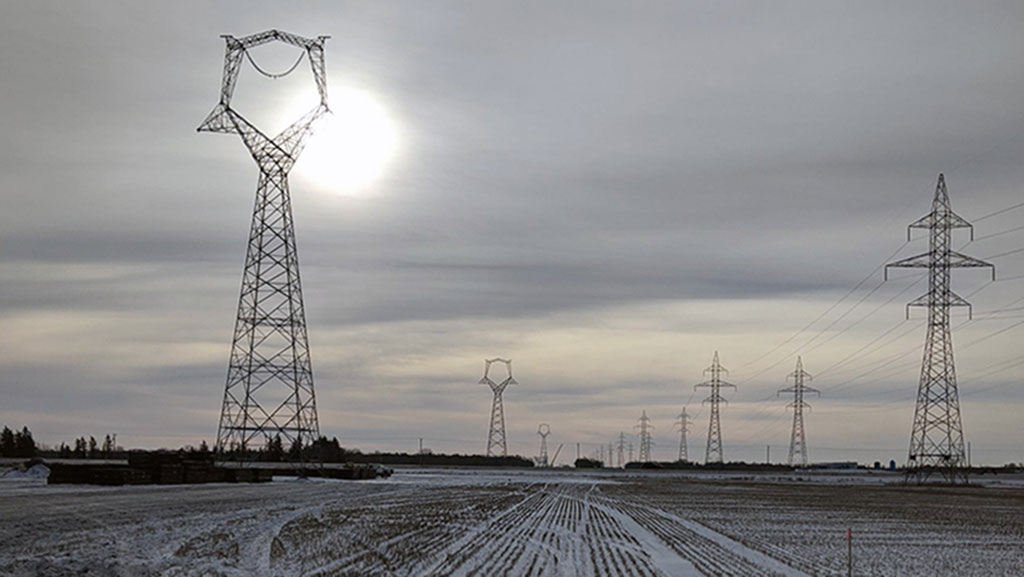Despite being faced with tough weather, a severely shortened construction timeline, boggy conditions and the COVID-19 pandemic, Manitoba Hydro was still able to complete the Manitoba–Minnesota Transmission Project (MMTP) on time this April.
Riley McDonald, a spokesperson for Manitoba Hydro, chatted with the Journal of Commerce about how the project team was able to pull off the 500-kV transmission line, which runs from the Winnipeg area to the U.S. border in southeastern Manitoba, in months instead of years.
How was Manitoba Hydro able to shorten its construction schedule?
“Manitoba Hydro was required to meet an in-service date of June 2020 in order to fulfill a contractual agreement with Minnesota Power for the delivery of power.
The schedule was reduced due to unexpected delays in the environmental approval process and once this delay was realized, steps were taken by the project management team to reduce the risk of the condensed construction schedule.
One of the key steps was a full-blown geotechnical exploration program by land and air, carried out the winter before construction began, for all tower sites that were not vegetated and accessible. This gave Manitoba Hydro engineers time to design the foundation types best suited for each tower and provide the general contractors time to prepare the required resources to meet the tight timelines.
Another important step was in the procurement of the construction contracts. The transmission line was divided into two segments and contracts were awarded to two separate contractors. This effectively doubled the amount of resources that were available to the project and gave each contractor a smaller scope of work to be completed in such a short period.
The construction for the first section of the transmission line was completed by the Muskeko Joint Venture, which consists of Swampy Cree Holdings, Sigfusson Northern and Voltage Power. The construction for the second section was completed by Valard Construction.”
How was weather a challenge for this project and how did the team deal with it?
“There were several challenges in this project and only a few involved weather. We had to deal with a wetter-than-normal fall season, which presented challenges for getting heavy equipment onto the project site.
Construction access matting was deployed heavily across the project and there were over 30,000 mats deployed over areas of the 214-kilometre-long transmission line. In October, we had an early winter storm that slowed construction due to the amount of snowfall, as the whole province had to dig out of it.
Weather was more favourable after this. The ground froze in early November, which allowed contractors access to most areas of the project site under frozen conditions. Winter temperatures were not unseasonably cold or warm (both of which would have made working more difficult) and spring thaw wasn’t until the end of March, which gave the contractor an extended season across the entire project area.”
What were some of the challenges related to working in boggy areas?
“Many of our transmission line projects experience conditions similar to those on MMTP, so the project team and the contractors were well-versed in dealing them.
However, having only one winter season to construct the transmission line was one of the higher risk-items, and approximately 35 kilometres of it required frozen conditions to access. Unfortunately, these areas were also vegetated and needed to be cleared before construction could commence. As the areas were vegetated, the geotechnical conditions present were also unknown — often within peat lands the conditions are very difficult, from a geotechnical perspective. Since we couldn’t bring in heavy equipment until the ground was frozen, and we needed to gain access as soon as possible to perform geotechnical exploration, we employed the contractor to clear a trail by chainsaw. The vegetation acts as insulation and prevents the ground from freezing, so by clearing a five metre (16 foot) trail, it started promotion of frost and allowed equipment access. Had we waited to use clearing equipment to start removal of the vegetation, we would have waited up to a month longer before there would have been sufficient frost to support it.”
How did the team overcome COVID-19 challenges when the virus hit?
“Manitoba Hydro developed a pandemic plan after the H1N1 crisis a few years ago, and that helped guide our response to the novel coronavirus pandemic. We were able to quickly implement work-from-home strategies for office staff and safe work procedures for our crews in the field to keep our employees and communities safe. The construction staff immediately formed different ‘bubbles,’ and interaction between them was eliminated or kept to a minimum to ensure other groups could carry on without having to self-isolate should one person be infected. As all of our work was outside, it was also easier to maintain physical distancing and continue to finish up the project.
These safe work procedures followed federal and provincial health guidelines and included increased hand sanitizing/washing protocols, wearing masks while around other people, and maintaining six feet of distance between people.”
Follow the author on Twitter @RussellReports.







Recent Comments
comments for this post are closed